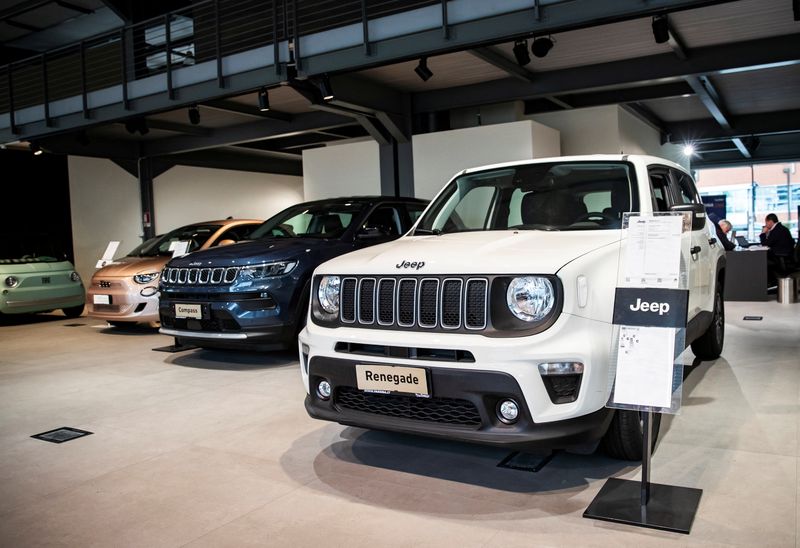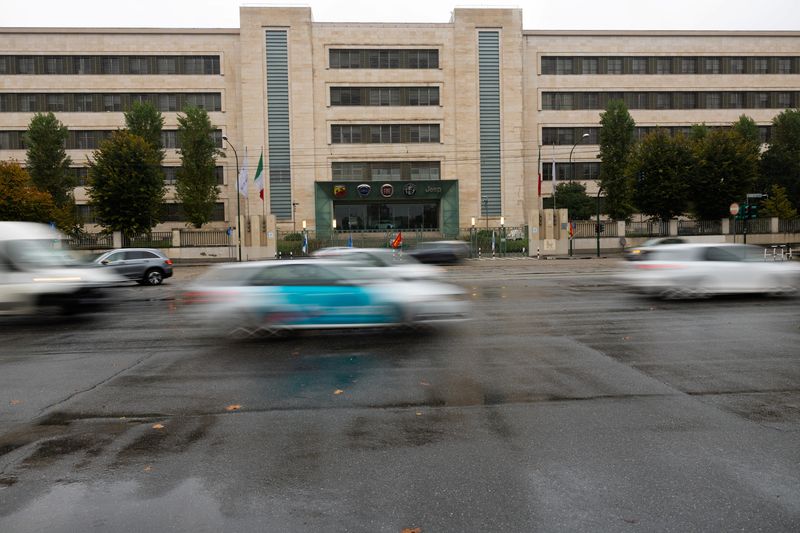By Giulio Piovaccari, Alessandro Parodi and Inti Landauro
MILAN (Reuters) - When 24-year-old Elena Aragon set out to buy a new car, she reviewed a range of no-frills brands in her home town of Cadiz (NASDAQ:CDZI), Spain, including Stellantis (NYSE:STLA)' Fiat (BIT:STLAM) and Peugeot (OTC:PUGOY).
In the end, she bought a Hyundai (OTC:HYMTF).
"The basic models for Fiat and Peugeot didn't appeal to me. But the more advanced ones, with the features I wanted, were too expensive," said Aragon, who opted to buy an i20 compact car with sensors for blind spots and a rear-view camera.
"I got a sweet discount and ended up paying 17,000 euros," the instructor at an air traffic controller school said.
Aragon's choice highlights a problem that had afflicted Stellantis under CEO Carlos Tavares, who quit abruptly on Sunday: rising prices at its mass-market marques have driven away inflation-hit customers, according to Reuters' interviews with five car dealers, five consumers, two auto industry executives ahead of his resignation and a review of pricing data by market research firm JATO Dynamics.
Tavares, who had led Stellantis since it was forged in January 2021 from the combination of Peugeot-owner PSA and Fiat Chrysler, had flattered investors with rapid post-merger cost cuts and boosted operating profit margins to around 13% last year, nearly twice those of rivals Volkswagen (ETR:VOWG_p) and Renault (EPA:RENA).
But his good start ran out after slumping sales and bloated inventories in the more profitable North American market led the group to issue a profit warning in September and later announce he would retire in 2026.
While investors focused on Stellantis' well-flagged U.S. travails, the group is however also struggling in its core European region, the Reuters review shows.
Under Tavares' leadership, Stellantis lost a third of market share in Europe. Over the same period, Fiat's market penetration in Europe halved to 1.8%, while Citroen's shrunk to 2.2%, data from European car association ACEA (BIT:ACE) show.
Stellantis' top investor is the Fiat-founding Agnelli family through investment company EXOR led by John Elkann.
The group said on Sunday it accepted Tavares's resignation "with immediate effect" and that Elkann would chair a new interim executive committee. Milan-listed shares were down 7% at 0834 GMT, their lowest since July 2022.
The European car dealers who spoke to Reuters point the finger at Tavares' focus on efficiency and margins.
"Low price models have progressively gone missing from Stellantis' range," says Alberto Di Tanno, founder of dealership group Intergea, which runs 169 outlets in Italy and Switzerland.
For example, the Ypsilon model from Lancia, one of 10 Stellantis brands available in Europe, "was a 17,000 euro car. Now, suddenly, it costs no less than 25,000 euros," said Di Tanno.
In September, the average retail price of a Stellantis passenger car in eurozone's 14 largest countries stood at nearly 40,000 euros, above the average for other mass-market competitors, JATO Dynamics data provided to Reuters show.
Cars from China's Saic, which owns British brand MG, went for 32,500 euros while models for Renault, Mitsubishi and Suzuki cost on average less than 29,000 euros.
Since 2021, prices at Stellantis have risen in each of Europe's five largest markets - Germany, France, Italy, Spain and United Kingdom (TADAWUL:4280). Hyundai and Toyota (NYSE:TM) have also hiked prices in these markets, but Volkswagen and Renault cut them.
"Prices are rising for the Stellantis brands, but customers still look at many of them as mass market," said JATO Senior Analyst Felipe Munoz.
A former veteran sales executive at Stellantis told Reuters that the higher price policy, as well as aggressive cost cuts, was part of Tavares' push for double digit operating income margin, particularly after the Covid pandemic.
Stellantis' struggles in Europe mirror some of the issues the company had been grappling with in North America with premium brand Jeep.
Erin Keating, executive analyst at Cox Automotive, said buyers have been shocked by the fact that Jeeps that retailed for $35,000 in 2019 shot past $60,000 this year, with some models even priced above $100,000. The cost of these models was tough to swallow for many buyers who prioritized Jeeps for their ruggedness and affordability.
"He chased profits. They shot the prices up of the vehicles, and I think what he forgot to do was to check, 'Who is my U.S. consumer?'" Keating said of Tavares.
Stellantis has told Reuters it's planning to launch approximately 20 new models in the next months, across all segments, aiming for a 20% market share in the European Union.
These include the Citroen C3, which starts at 23,000 euros in its electric version but costs less than 15,000 euros with a combustion engine.
FAILED AMBITION
Like with other European carmakers, Stellantis' problems in Europe had been exacerbated by fierce competition from Asian rivals, including from Hyundai and Toyota.
Chinese automakers including BYD (SZ:002594), which collectively account for around 5% of European auto sales and could command a 12% market share by 2030 according to consultant AlixPartners, undermined Stellantis' offerings.
The small Fiat 500, traditionally associated with affordable mobility, is on sale only as an electric vehicle, for about 29,000 euros.
"(Stellantis') prices are not the right ones," said Tony Fassina, founder of one of the biggest car dealers in Milan, Italy. "At the appropriate prices demand is there."
Herman Claes, chairman of the Stellantis Retailer Association for Belgium and Luxembourg, said more and more Stellantis dealers in the region had started to offer other marques to compensate for slower sales, to the advantage of Chinese automakers.
The group's complexity has also been an issue.
With 14 brands globally, Stellantis owns the largest number of marques among traditional automakers. After spinning off Porsche in 2022, Volkswagen operates nine brands. Toyota owns just three.
Stellantis' wide portfolio has however failed to ensure clearly differentiated products: Fiat and Citroen compete in the cheaper segment, Jeep and Alfa Romeo in the premium space.
To secure savings, Stellantis' mid-sized vehicles are being developed on the same STLA Medium technology platform, while smaller cars use Peugeot's CMP platform.

"Many Stellantis models overlap," said Plinio Vanini, owner of Italy's largest dealership group Autotorino.
($1 = 0.9477 euros)
